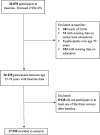Longitudinal cholesterol trends across socioeconomic groups in Norway: the influence of lipid-lowering drugs in the population-based Tromsø Study 1994-2016
- PMID: 39725421
- PMCID: PMC11683920
- DOI: 10.1136/bmjopen-2024-089819
Longitudinal cholesterol trends across socioeconomic groups in Norway: the influence of lipid-lowering drugs in the population-based Tromsø Study 1994-2016
Abstract
Objectives: There is limited evidence regarding the impact of lipid-lowering drugs (LLDs) on the socioeconomic gradient in a longitudinal perspective. The study investigates the longitudinal socioeconomic gradient in total cholesterol levels and whether this is affected by the use of LLDs.
Design: Population-based cohort study.
Setting: Sample from adult inhabitants of Tromsø municipality, Norway, who participated in the Tromsø Study (1994-2016).
Participants: 17 550 participants of the population-based Tromsø Study in 1994-1995 who were non-users of LLD, aged 25-78 years at baseline and who attended one or more of three subsequent surveys in 2001, 2007-2008 and 2015-2016 were included in the study.
Outcome measure: Socioeconomic gradient in total cholesterol levels was compared among participants treated and not treated with LLDs during the observation period.
Results: The total cholesterol levels across all educational groups increased from 1994-1995 to 2015-2016 among untreated women (+0.33 mmol/L to +0.48 mmol/L), except for those with primary education (-0.12 mmol/L). Total cholesterol levels decreased among untreated men (-0.40 mmol/L to -0.06 mmol/L, from lowest education to highest education), treated women (-1.88 mmol/L to -1.35 mmol/L) and men (-2.21 mmol/L to -1.84 mmol/L) across all educational groups. At baseline, we observed a significant inverse association between education and total cholesterol levels among non-users of LLDs. There was no clear educational gradient in total cholesterol levels among users of LLDs.
Conclusions: Users of LLDs experienced a more substantial decrease in total cholesterol levels over time compared with non-users. The educational gradient in total cholesterol levels observed among non-users of LLD was not apparent among users.
Keywords: Cardiovascular Disease; Drug Therapy; EPIDEMIOLOGIC STUDIES; EPIDEMIOLOGY; Risk Factors.
© Author(s) (or their employer(s)) 2024. Re-use permitted under CC BY-NC. No commercial re-use. See rights and permissions. Published by BMJ Group.
Conflict of interest statement
Competing interests: None declared.
Figures


Similar articles
-
Whom are we treating with lipid-lowering drugs? Are we following the guidelines? Evidence from a population-based study: the Tromso study 2001.Eur J Clin Pharmacol. 2004 Nov;60(9):643-9. doi: 10.1007/s00228-004-0827-z. Epub 2004 Sep 29. Eur J Clin Pharmacol. 2004. PMID: 15455181
-
Longitudinal and secular trends in total cholesterol levels and impact of lipid-lowering drug use among Norwegian women and men born in 1905-1977 in the population-based Tromsø Study 1979-2016.BMJ Open. 2017 Aug 21;7(8):e015001. doi: 10.1136/bmjopen-2016-015001. BMJ Open. 2017. PMID: 28827236 Free PMC article.
-
Associations between body height and cardiovascular risk factors in women and men: a population-based longitudinal study based on The Tromsø Study 1979-2016.BMJ Open. 2024 Oct 17;14(10):e084109. doi: 10.1136/bmjopen-2024-084109. BMJ Open. 2024. PMID: 39419617 Free PMC article.
-
Trends in cardiovascular risk factors across levels of education in a general population: is the educational gap increasing? The Tromsø study 1994-2008.J Epidemiol Community Health. 2014 Aug;68(8):712-9. doi: 10.1136/jech-2013-203428. Epub 2014 Mar 27. J Epidemiol Community Health. 2014. PMID: 24675289
-
Medical lipid-regulating therapy: current evidence, ongoing trials and future developments.Drugs. 2004;64(11):1181-96. doi: 10.2165/00003495-200464110-00003. Drugs. 2004. PMID: 15161326 Review.
References
MeSH terms
Substances
LinkOut - more resources
Full Text Sources
Medical
